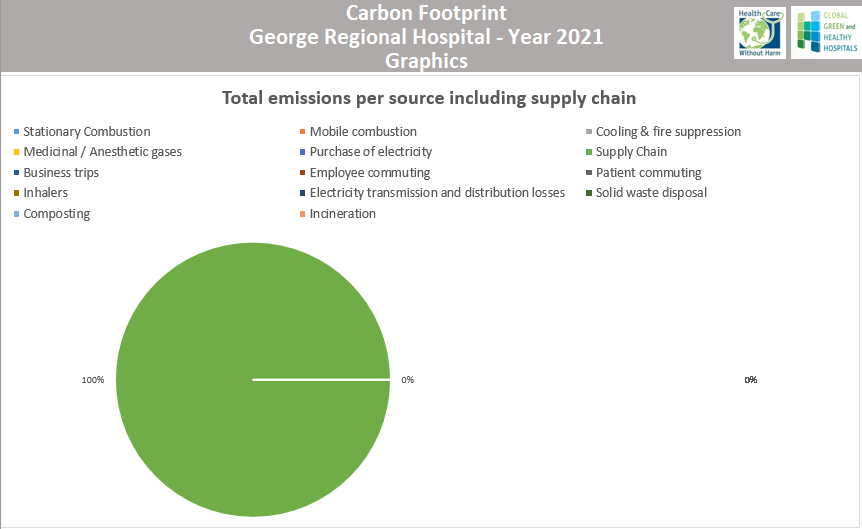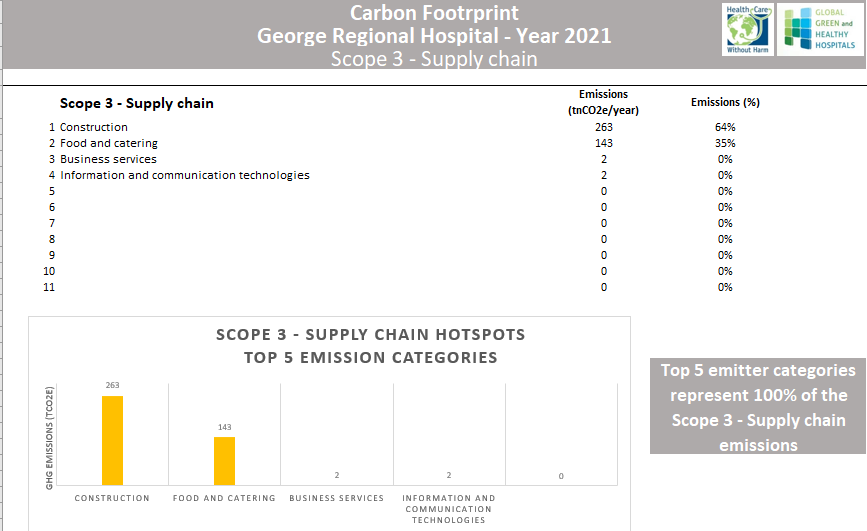Sustainable public procurement at health care facility level
George Regional Hospital, Department of Health, Western Cape, South Africa.
Case study highlights
George Hospital is a public health facility and regional hospital but renders some tertiary services. This case study focuses on the processes and progress on procurement of environmentally responsible alternative products and consumables as implemented through various initiatives since 2019.
George Regional Hospital incorporated an environmental focus as one of the institution’s six priorities in their mission and strategic priority for environmentally responsible health care. Since 2016, George Regional Hospital has been part of Global Green & Healthy Hospitals.
Demographic information
- City: George
- State/province/region: Western Cape
- Country: South Africa
- Type of institution: Public hospital
- Number of full-time staff: 800
- Number of part-time staff: 80
- Patient population served annually: Inpatients (1,700), emergency (4,000), outpatient (5,400), extensive outreach programs to population of 713,225.
- Geographic area served: Garden route and Central Karoo 62 185 km2
- Number of beds 285
The issue
This strategic priority was initiated in response to environmental pollution and resource consumption concerns, which are being addressed through procurement strategies to manage water, electricity, waste (medical and organic), and cleaning products. In particular, waste generated by health care impacts air and water quality, which in turn impacts public health.
Hospital goal
The goal of this initiative is to position George Hospital as a health system leader in Western Cape Rural Health Service in responding to climate change and providing more sustainable health care. Specific items include:
- Securing funds for staff or consultants to assist with the design of the action plan.
- Reducing energy costs.
- Reducing carbon dioxide emissions.
- Encouraging staff to carpool and cycle to work.
- Establishing an extreme heat emergency response plan with the local community.
- Making progress on health equity goals.
- Transitioning from conventional chemical products that have not been designed to prevent environmental and human health harm.
- Advocating for more environmentally friendly practices within the broader health system network.
Sustainability strategy implemented
Hospital leaders aimed to leverage their goods and services budget, which in 2020 and 2021 amounted to R151 million (USD 8,161,097). Specifically the plan looked at:
- Sustainable procurement strategies, policy, and plans.
- High-impact procurement opportunities considering which sustainability concerns are a priority for upcoming procurement/tender events.
- Training and communication.
- Revising standard operating procedures.
- Engaging with suppliers around sustainable procurement and alternatives.
- Promoting supplier leadership in innovation.
- Tracking and monitoring data, as well as preparing sustainability procurement reports.
Hospital leaders established key performance indicators that defined and tracked procurement and supply chain objectives, regularly reviewed progress and adjusted strategies as needed, and monitored supplier performance and cost savings.
Implementation process
Implementation began with a conversation between procurement officials and the team on sustainability, focused on why the changes matter and what can be done about it.
Western Cape Department of Health Procurement specialists brought knowledge and expertise on contract management, procurement, and interpretation of policies and prescripts. Procurement specialists received training on conducting market research, testing markets for sustainable products, and writing and compiling specifications inclusive of “environmentally friendly/biodegradable products.” The team reviewed best practices within the Department of Health and revised technical specifications to find environmental alternatives that met functionality criteria.
This process also considered ethical sourcing, human rights, and child labor along with sustainability benefits. This included a lifecycle approach to chemical consumption, reduced use of hazardous chemicals for lower local environmental impact, local and environmentally responsive market development, and reduced aquatic system pollution.
The team fostered strategic supplier relationships to develop long-term partnerships to encourage collaboration and innovation. A successful supplier open day was held in January 2020 and the response was overwhelming, initiating a conversation about sustainable procurement. They provided inputs to specifications as specialists in their respective fields.
The team also engaged the community by raising awareness, organizing, collaborating, and helping others as a fundamental component of their success. End users of the hospital such as clinicians, nurses, support staff, and facility management staff were educated to understand str they could use at work and at home. The strategies had to be reviewed every three months along with inventory levels to adjust as needed and minimize carrying costs and stockouts. By leveraging digital procurement tools, the facility is able to streamline processes and maximize cost savings.
Tracking progress
No targets were set for this project, as this was a relatively new concept for public procurement. However, the organization was one of three institutions in South Africa identified to pilot the Global Green and Healthy Hospitals carbon footprint tool, which enabled the facility to measure its carbon footprint within supply chain management using expenditure costs.
The tool identified the top supply chain emission categories:
- Construction
- Food and catering services
- Business services
- Information and communication technologies
The results are ranked by their GHG emissions to easily identify hotspots in the supply chain. The following graphics include results within the supply chain compared with the whole GHG Inventory.


Progress
The following are examples of innovative and environmentally sustainable initiatives that were prioritized to achieve significant carbon footprint reduction, cost savings, and sustainable waste management.
Recycling
- Revision of service contract with the onsite recycling service (paper, plastic, glass, tins).
- Sale of scrap metal from crushing condemned/redundant medical equipment, which normally would have been dumped at landfills.
- Battery collection to prevent used batteries from being thrown into normal waste.
Packaging
- New hygiene tender specifications incorporating environmentally friendly products.
- Identified 14 green suppliers with 100% recyclable packaging.
- Reduced harmful chemicals by using an alternative to boracic soap and biodegradable cleaning products.
- Stopped using 100% virgin plastic waste bags.
- Switched to reusable cloth bags for dialysis patients’ medicine.
- Transitioned to brown paper bags in the pharmacy.
- Sugarcane food containers replaced polystyrene food containers.
- Paper cups replaced by water filters/fountains.
Local procurement
- Switched from imported chicken to one proudly South African.
Challenges and lessons learned
Tackling climate-related impacts requires a whole-system approach. An important success factor was the initial buy-in and support by all staff, including hospital management. This caused it to become a bigger part of our collective conversations about how everyone can change their habits to align with the mission, vision, and strategic priorities of the institution. Embedding indigenous knowledge and voices in curricula will better prepare an environmentally responsible health care workforce.
It is important to ensure good governance by making transparent and accountable choices that align with strategic priorities, particularly in a resource-constrained environment.
Specifications are key to implementing green procurement and support replication. In order to reduce waste to landfills, plastic bottles and container specifications should be 100% consumer-recycled plastic that’s also 100% recyclable, and cardboard boxes can be swapped for fully recyclable polypropylene bags. Data show that 176 000 bags represent a savings total of 8.44 tons of unnecessary cardboard packaging that would ultimately land up in landfills.
Health care facilities are already stretched with huge budget cuts and constraints, which can create challenges with supplier engagement. Suppliers were hesitant to get involved and made the assumption that it would not be cost-effective. There were also limited local suppliers or they were not registered on the procurement database.
Next steps
George Hospital aims to scale up further by conducting a cost analysis on sustainable products that were introduced and implemented. This data will then be considered for publication in supply chain and procurement journals. In addition, the facility aims to pursue:
- Leadership opportunities to intensify commitment to green procurement.
- Share case study presentations at different forums.
- Cost analysis of sustainable procurement compared to traditional procurement.
- Building relationships, collaborations, and benchmarking.
- Environmentally friendly supply chain networks for sustainable growth.